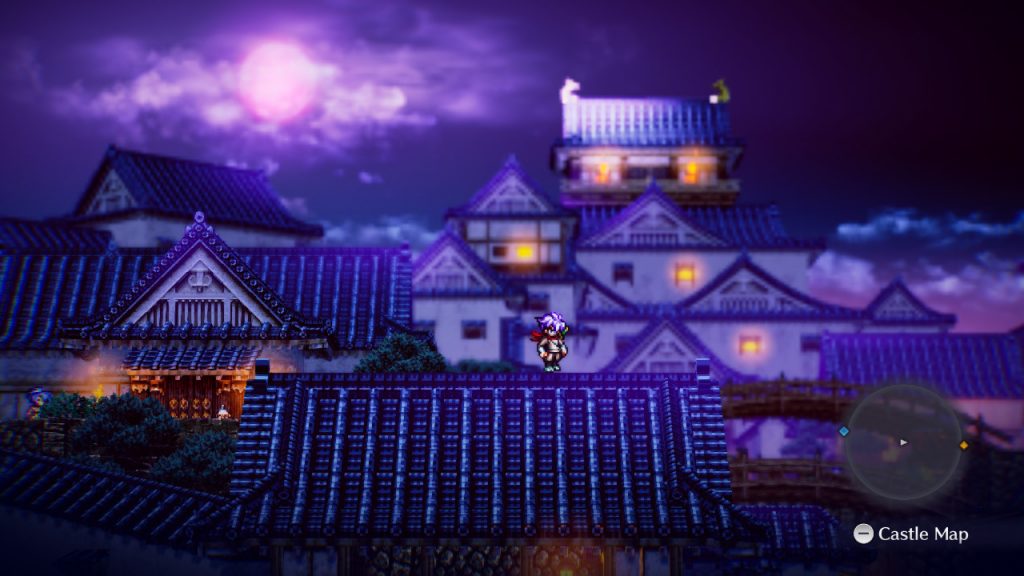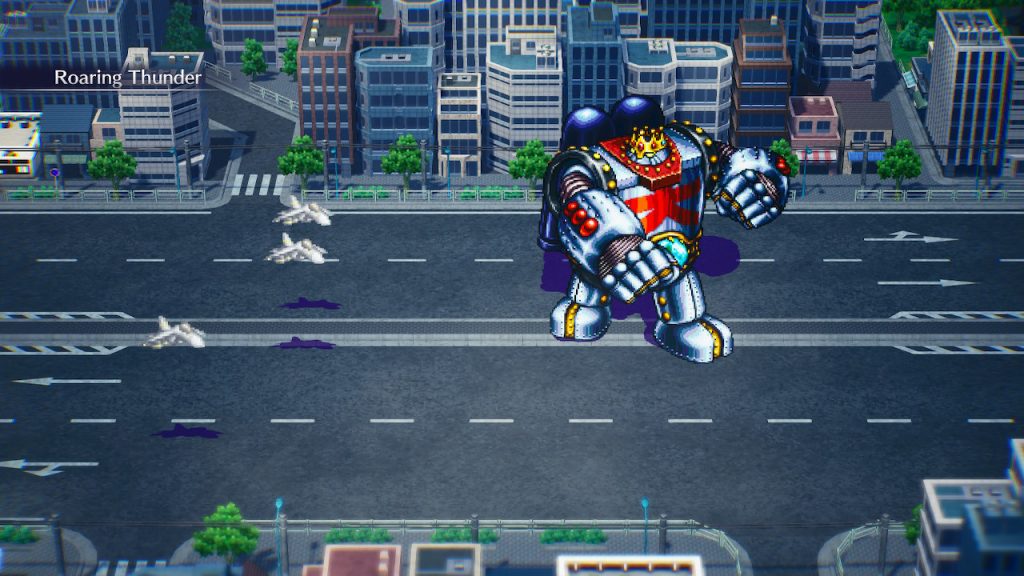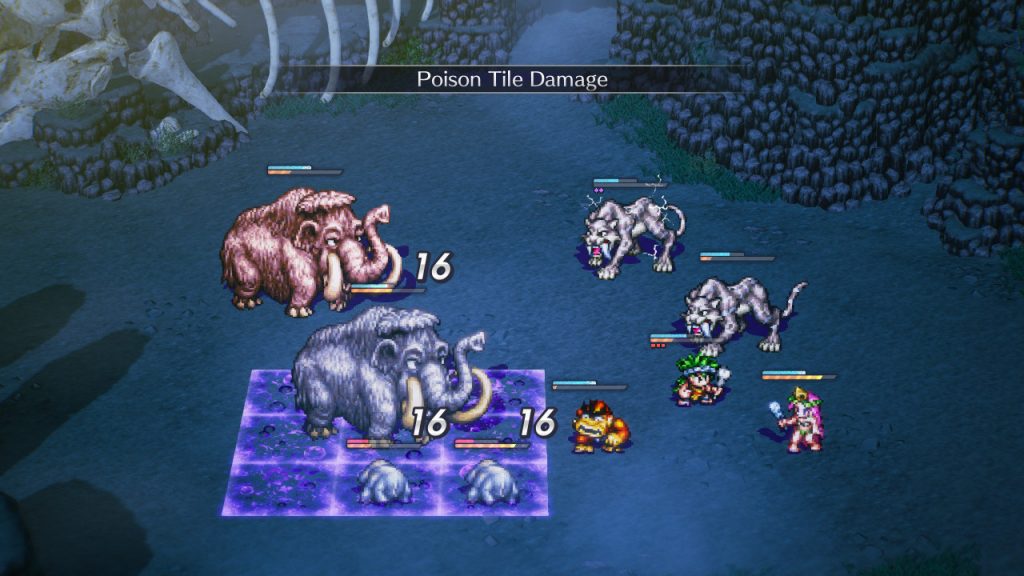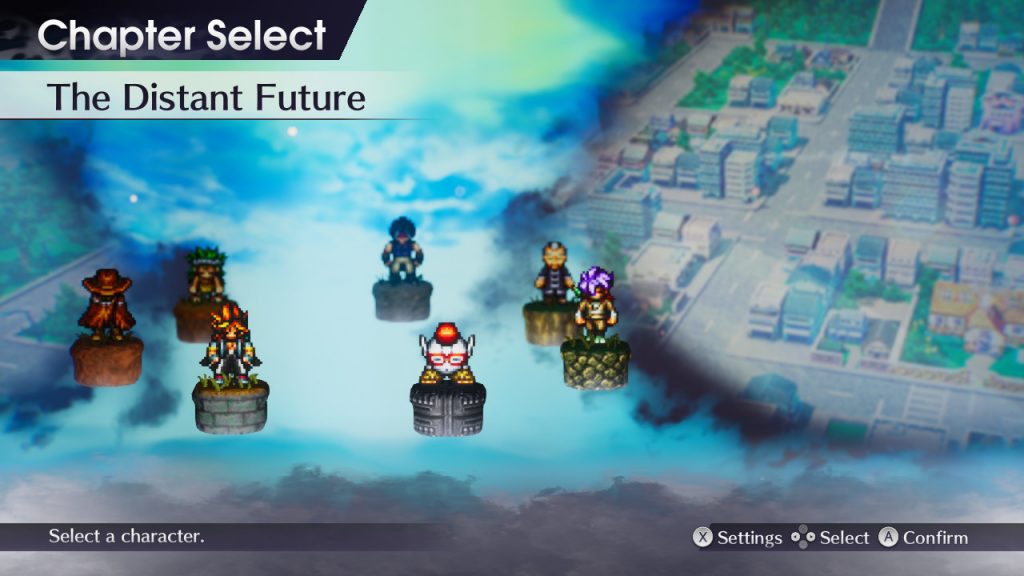Live A Live bundles together a collection of vignettes that intertwine in subtle, curious ways. Almost every scenario in the game pulls from the same bank of mechanics. While you’ll do much of the same from one story to the next, there are enough differences across each time period that most every story feels wholly unique.
Yet Live A Live is, at times, plagued by pacing issues, the occasional lack of direction, and a fair amount of backtracking. Despite its faults, it is still a worthwhile romp through history and time. Much of this is thanks to its distinct and lovable characters – from a stealthy ninja in feudal Japan to winning over the folks in the Wild Wild West as the most wanted man in town.
Live A Live’s very existence as a remake is curious. The game released in 1994 for the Super Famicom just a few months after the undeniable hit JRPG Final Fantasy 6. Unfortunately, despite a strong directorial debut for Takashi Tokita (who would go on to head up projects like Chrono Trigger and Parasite Eve) the game sold just over a quarter million copies in Japan. Unsurprisingly, it’s considered a commercial failure.
Yet, time proved favorable to Tokita’s debut. As years passed, Live A Live has established itself as a cult classic, bringing us to today. The game presents 7 scenarios to explore that you can complete in any order. You can even save and exit from a scenario and jump to another if you get bored or stuck. This is bolstered by the non-linear narrative, helping this almost 30 year old game stand out today.
All Glown Up

Live A Live truly deserves the new life affoded by a remake. It follows the path carved by games like Octopath Traveler and Triangle Strategy with its HD-2D world. This is a huge step-up from its original 16-bit design, though it retains much of its original charm. It’s an absolute visual feast.
The game begins with seven different scenarios to choose from, and each stands out for different reasons. You’ll get to travel to the far reaches of space in an isolated spaceship in one and journey to the beginning of time in a prehistoric world in another. Each scenario combines 16-bit nostalgia with an updated 3D world that uses light expertly and looks smooth and glossy.
Pixel Near-Perfect
Some scenarios are more visually stunning than others, though. The Twilight of Edo Japan features some truly beautiful moments running across rooftops as the sneaky ninja Oboromaru is silhouetted against a waxy moon and purple sky. Moments like this also have a better sense of scale than the 16-bit version. Buildings of different heights line up, creating even more visual variety.
The Near Future follows Akira in a familiar RPG-style quest fueled by human sacrifice, giant robot mechs, and telepathy. It’s the only scenario to feature a world map you travel to get from place to place, and the city’s brightly colored world looks great. It’s also one of the scenarios that I found suffered in some ways aesthetically. Many of the interiors found later in the story are fairly uninspired. So many of the game’s cities and biomes look great – so it stands out when something (rarely) falls flat.
Go! Go! Steel Giant!

Remakes are almost always defined by how they look, but most feature an updated score and the addition of voice acting. Thankfully, Live A Live features both. Sometimes, a game’s updated score can go under-appreciated but I wanted to take time to mention Live A Live’s score. The music was written by Yoko Shimomura of Kingdom Hearts game. Her score for the original Live A Live was her first project for Square, and after, she went on to have a fantastic career.
Shimomura returns for the remake and her updated score, including a vocal version of “Go! Go! Steel Giant!,” is superb. Each scenario is all the more distinct thanks to her contributions. Each selection of tunes only lifts each scenario to new heights and there are many tracks worthy of adding to your video game music playlist if you’re into that kind of thing.
The game’s voice performances also only enhance the story-telling. Sitting back and listening to narratives unfold across sprawling backdrops of sun-drenched castles in the Middle Ages or hearing the manic tales of scientists lost in space only improves the experience.
A Unique Take on the Jrpg

From the original to the remake, much of the gameplay didn’t change too much. While the 2022 version includes a map-like radar, balance and UI changes, it’s still faithful to its take on turn-based, tactical style battles. Every scenario features (though all do not require the use of) turn-based battles on a grid. As a huge fan of JRPGs, I felt right at home.
Battles take place on a 7×7 grid. Each grid square can be imbued with status effects which adds a welcome level of strategy. While each scenario features different abilities and party members, across all scenarios are the same elements and types of moves – from fire and ice to long range and foot or arm-based attacks.
The variety of abilities across timelines help each character feel distinct and unique. Thankfully, there’s little need to relearn a new battle system when you move from one story to the next. The game also heals you after battle and abilities can be used without measure, though some can take a few turns to charge. Battles also present you each enemies’ weakness, so it’s easy to plan what attacks to use. These allow scenarios to progress more quickly than other long-form JRPGs where one must constantly heal HP and MP.
Party Up
What helps each story stand out from one another besides its narrative, time period, and character is the unique actions available to that scenario’s hero. For example, in Prehistory as Pogo, you can press Y to sniff about and find items and enemies.
In the Present Day scenario, the entire structure is different from any other. It plays out like a fighting game as you control Masaru Takahara. He wants to become the strongest fighter in the world. You’ll select opponents from a fighting game-style character screen and then bait them into using specific moves on you that you’ll then learn.
The biggest standout mechanically is The Twilight of Edo Japan scenario. It’s heavily stealth based. The entire journey can be completed without killing a human (though there are non-human enemies you’ll take down). If you do want to kill, you can kill everyone. The game rewards you for killing all 100 people within the walls of the village and fortress.
It’s these unique mechanics scattered across the game’s scenarios that help alleviate some of the pacing issues found within the game. Some scenarios are an hour or so while others can take up to four or five. Even the best scenarios are hampered by going back and forth from the same locations. Backtracking becomes a sport throughout some of the scenarios. You’ll move between two locations a handful of times just to expedite information between people. It’s not inspiring, but battles between and the game’s unique mechanics help to somewhat offset it.
What a Tale We Weave

Live A Live’s narrative strengths vary from scenario to scenario. During my 24 or so hours with the game, I almost always left the end of a scenario wanting more. While each consists of its own self contained story, I wanted more. Which is impressive I tend to either prefer longer stories like those in Persona 5 Royal or The Witcher 3, or smaller, bite-sized shorts.
On the whole, though, it makes sense. Once you’ve beaten the seven initial scenarios, an eighth opens up. By the end of that, it becomes quite clear what threads have been drawn from the first seven to the eighth, and it’s really quite clever. Once that eighth scenario ends, which narratively I enjoyed the most, the game’s final scenario opens up.
It’s here the game feels most complete as everything connects. You’ll have a full party, there are optional bosses and dungeons to explore. It’s the classic JRPG portion of the game without the previous gimmicks taking center stage. It does get a bit grindy, however, thanks to the inclusion of random encounters.
A Product of Its Day
Finally, I know the game was written in the early 90s, but I did find myself frustrated with the way the game handles its female characters. For one, there is not really a female protagonist. One scenario has you choose a successor. It’s possible that person can be female and be available later, but that’s about it. Most of the female figures in the game don’t reach the heights of their male counterparts. The next paragraph will feature non-scenario specific spoilers.
In one scenario, the only female character is obsessed with her lover and loses her mind after his death. She eventually smuggles his body into her room and treats his corpse like he is still alive. Another features a princess seemingly defined by her helplessness and love. It ends with a Romeo and Juilet-like scenario. Most other females in the game exist as background fodder or as the role of “wife” or “mother.” As someone who grew up obsessed with bad-ass female heroes, seeing a lack of strong-female characters here disappointed me.
Final Verdict
I went into Live A Live with little knowledge of the game’s history or how the story would play out. By the game’s end, I found myself happy to have journeyed across hundreds of years of space and time even if the journey was occasionally hampered by pacing issues. Many of the game’s narratives tell some really exemplary stories, with the Distant Future and the Middle Ages featuring two of my favorites. Even those with stories I didn’t care too much about featured exciting mechanics and stunning visits that helped elevate it even higher. If you’re at all interested in JRPGs or cult classic games, Live A Live is worth your time.


